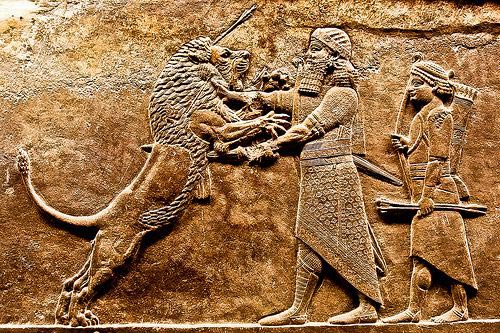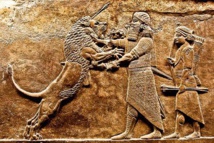Then, some 3,000 years ago, it had a huge palace. Today it's a priceless archaeological site and a candidate for listing as a UNESCO World Cultural Heritage Site.
"They said, open all the doors and windows. There is going to be a huge explosion," Abu Djasim recalls. Six hours later, a detonation shook the region, one felt not only in the houses in his village. The Islamic State terrorists had used tons of explosives to lay waste to Nimrud, located 30 kilometres south of their former stronghold of Mosul.
Videos show a huge shock wave that sent a mushroom-like cloud of dust shooting up into the sky. Pieces from the explosion landed as far as 10 kilometres away, Abu Djasim said. The jihadists also used bulldozers and pneumatic drills to destroy the most important remaining ruins.
It is very well possible that before they destroyed the place, the extremists took smaller artefacts and sold them. Abu Djasim even believes that Islamic State blew up Nimrud to cover up their illegal trade. Before the explosion, he had seen some "strange vehicles" at the archaeological site. "Perhaps the traders brought them here."
Now Abu Djasim, who had previously helped out in archaeological digs, is standing amid what remains from the gigantic explosion at the royal palace - dust, rocks, and the remains of walls looking as desolate and parched as the nearby grass and thistles.
"There," he suddenly points. "Earlier there had been a large bas relief, an entire wall, metres long." The relief had shown scenes of military campaigns and sieges, a unique testimony of a highly-advanced culture.
But for the Islamic State fanatics, such archaeological remains were symbols of a culture of infidels before Islam that therefore must be destroyed. The extremists also destroyed several millennia-old archaeological sites in nearby Hatra and Mosul. Precious cultural items were destroyed the way they had been in the Syrian coastal city of Palmyra.
"Daesh left nothing behind," Abu Djasim said, using an Arabic acronym for Islamic State.
Archaeologists were shocked when learning of the destruction at Nimrud. "It is on the same level as the destruction of Palmyra," said Stefan Hauser, professor of archaeology at the University of Konstanz. "In Nimrud, a complete artwork of architecture and sculptures has been lost."
But the situation is now made even worse because the site is experiencing a fresh drama. It is more than half a year since the region was liberated from Islamic State, but so far there has been no systematic assessment made of the overall damage.
"Nothing has happened yet," says archaeologist Layla Saleh. She is the former head of the local authority for cultural heritage and now active for the non-governmental organization the Gilgamesh Centre for Antiquities and Heritage Protection in Baghdad.
Faisal Jaber, deputy head of the NGO, adds: "The Iraqi State Board of Antiquity and Heritage has not allowed until now more than 300 employees to resume their work in the Mosul directorate due to the delay in security validation. Even after eight months, not a single employee has obtained clearance."
Jaber alleges that there are political reasons for the inaction. Iraq's government is dominated by the Shiite majority, but Nimrud lies in the core region of the Sunnis, who for years now have been complaining about discrimination. Ever since the toppling of dictator Saddam Hussein in 2003, Nimrud had been neglected, Jaber said.
The rubble there, which from an archaeological standpoint remains valuable, is now exposed unprotected to the elements. Among the remains are the more than human-sized winged bulls that had once flanked the entrance to the palace. They are now lying haphazardly on top of a pile of other rubble. A protective tarpaulin that activists had placed over it it as an emergency step has vanished.
For a long spell the liberated grounds went additionally without anyone guarding them. Experts fear that as a result pieces of what had survived might have fallen into the hands of robbers. Recently, however, workers set up a fence around it, financed by UNESCO.
Salim Khalaf, a member of Iraq's Ministry of Culture dealing with antiquities issues, points to the difficult security situation in northern Iraq. "We have initial plans for reconstruction, but they can't be carried out yet because the liberation operation in the region is still going on," he said.
What is also needed is foreign assistance and huge sums of money. Iraq is working together with UNESCO, Khalaf noted.
What remains for Abu Djasim is his memory of the place that will never again be what it once had been. "I knew this spot like my own house," he said. "I have it all stored in my head."
---------------------------------------------------------------------------------------------------------------------------
"They said, open all the doors and windows. There is going to be a huge explosion," Abu Djasim recalls. Six hours later, a detonation shook the region, one felt not only in the houses in his village. The Islamic State terrorists had used tons of explosives to lay waste to Nimrud, located 30 kilometres south of their former stronghold of Mosul.
Videos show a huge shock wave that sent a mushroom-like cloud of dust shooting up into the sky. Pieces from the explosion landed as far as 10 kilometres away, Abu Djasim said. The jihadists also used bulldozers and pneumatic drills to destroy the most important remaining ruins.
It is very well possible that before they destroyed the place, the extremists took smaller artefacts and sold them. Abu Djasim even believes that Islamic State blew up Nimrud to cover up their illegal trade. Before the explosion, he had seen some "strange vehicles" at the archaeological site. "Perhaps the traders brought them here."
Now Abu Djasim, who had previously helped out in archaeological digs, is standing amid what remains from the gigantic explosion at the royal palace - dust, rocks, and the remains of walls looking as desolate and parched as the nearby grass and thistles.
"There," he suddenly points. "Earlier there had been a large bas relief, an entire wall, metres long." The relief had shown scenes of military campaigns and sieges, a unique testimony of a highly-advanced culture.
But for the Islamic State fanatics, such archaeological remains were symbols of a culture of infidels before Islam that therefore must be destroyed. The extremists also destroyed several millennia-old archaeological sites in nearby Hatra and Mosul. Precious cultural items were destroyed the way they had been in the Syrian coastal city of Palmyra.
"Daesh left nothing behind," Abu Djasim said, using an Arabic acronym for Islamic State.
Archaeologists were shocked when learning of the destruction at Nimrud. "It is on the same level as the destruction of Palmyra," said Stefan Hauser, professor of archaeology at the University of Konstanz. "In Nimrud, a complete artwork of architecture and sculptures has been lost."
But the situation is now made even worse because the site is experiencing a fresh drama. It is more than half a year since the region was liberated from Islamic State, but so far there has been no systematic assessment made of the overall damage.
"Nothing has happened yet," says archaeologist Layla Saleh. She is the former head of the local authority for cultural heritage and now active for the non-governmental organization the Gilgamesh Centre for Antiquities and Heritage Protection in Baghdad.
Faisal Jaber, deputy head of the NGO, adds: "The Iraqi State Board of Antiquity and Heritage has not allowed until now more than 300 employees to resume their work in the Mosul directorate due to the delay in security validation. Even after eight months, not a single employee has obtained clearance."
Jaber alleges that there are political reasons for the inaction. Iraq's government is dominated by the Shiite majority, but Nimrud lies in the core region of the Sunnis, who for years now have been complaining about discrimination. Ever since the toppling of dictator Saddam Hussein in 2003, Nimrud had been neglected, Jaber said.
The rubble there, which from an archaeological standpoint remains valuable, is now exposed unprotected to the elements. Among the remains are the more than human-sized winged bulls that had once flanked the entrance to the palace. They are now lying haphazardly on top of a pile of other rubble. A protective tarpaulin that activists had placed over it it as an emergency step has vanished.
For a long spell the liberated grounds went additionally without anyone guarding them. Experts fear that as a result pieces of what had survived might have fallen into the hands of robbers. Recently, however, workers set up a fence around it, financed by UNESCO.
Salim Khalaf, a member of Iraq's Ministry of Culture dealing with antiquities issues, points to the difficult security situation in northern Iraq. "We have initial plans for reconstruction, but they can't be carried out yet because the liberation operation in the region is still going on," he said.
What is also needed is foreign assistance and huge sums of money. Iraq is working together with UNESCO, Khalaf noted.
What remains for Abu Djasim is his memory of the place that will never again be what it once had been. "I knew this spot like my own house," he said. "I have it all stored in my head."
---------------------------------------------------------------------------------------------------------------------------









 Home
Home Politics
Politics











